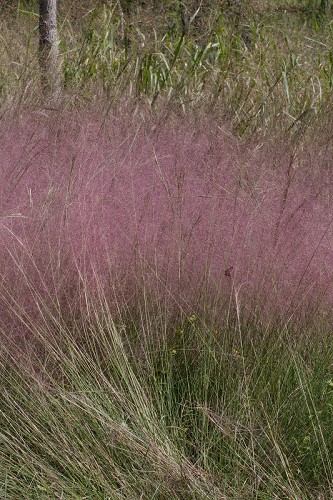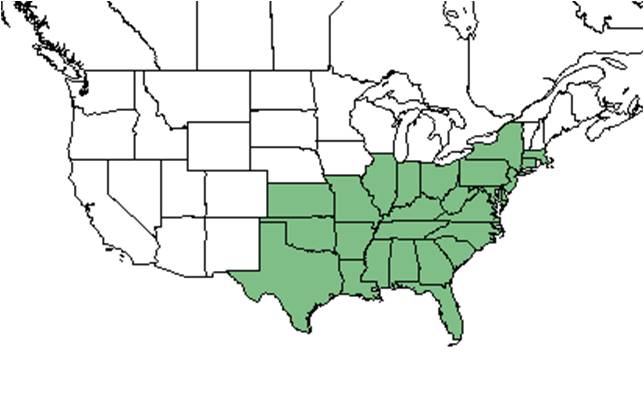Muhlenbergia capillaris
| Muhlenbergia capillaris | |
|---|---|

| |
| Photo by John R. Gwaltney, Southeastern Flora.com | |
| Scientific classification | |
| Kingdom: | Plantae |
| Division: | Tracheophyta- Vascular plants |
| Class: | Lilianeae -Monocotyledons |
| Order: | Poales |
| Family: | Poaceae |
| Genus: | Muhlenbergia |
| Species: | M. capillaris |
| Binomial name | |
| Muhlenbergia capillaris (Lam.) Trin. | |

| |
| Natural range of Muhlenbergia capillaris from USDA NRCS Plants Database. | |
Common names: Hairgrass[1]
Contents
Taxonomic notes
Synonyms: none.[1]
Varieties: none.[1]
Description
"Perennials. Blades usually scaberulous on both surfaces and margins; sheath margins scarious, at least apically; ligules scarious, erose or erose-ciliate. Spikelets 1-flowered. Glumes equaling or shorter than lemmas, lemmas not indurate. Grain enclosed by lemma and palea at maturity."[2]
"Cespitose perennial; culms 5-12 dm tall, nodes and internodes glabrous. Leaves primarily basal; blades flat or involute, to 3 dm long, 103 mm wide; sheaths scaberulous; ligules 2-5 mm long. Panicle open, diffuse, delicate, 2-5 dm long, 1-2 dm broad; branches capillary, spreading, scaberulous. Spikelets usually purplish, lanceolate to narrowly ellipsoid, 4-5 mm long excluding awn; pedicels capillary, spreading, scaberulous. Glumes usually 1-nerved, usually scaberulous on midrib, scarious, 1st glume body 0.3-1.2 mm long, awn 0.3-1.2 mm long, 2nd glume body 1-1.5 mm long, awn 1-1.5 mm long; lemmas purplish, 3-nerved, scaberulous, body 3-4 mm long, awns 3-12 mm long; paleas purplish, faintly nerved, acuminate, 3-4 mm long. Grain purplish, narrowly ellipsoid, 2-2.4 mm long."[2]
Distribution
M. capillaris ranges from Massachusetts, New York, southern Ohio southern Indiana, southern Illinois, Missouri, and eastern Kansas to southern Florida, Louisiana, and southern Texas.[1]
Ecology
Habitat
M. capillaris has been found in marshes, open pineland, pine-turkey oak flats, drained buttonwood flats, sandy ridges, limerock, slash pineland, treeless chalk glades, and dike crests.[3] It is also found in disturbed areas including cleared construction sites, powerline corridors, roadsides, burned slash pine-scrub flats, and disturbed longleaf pinelands.[3] Associated species: Sporobolus junceus, Dichanthelium dichotomum, Rudbeckia flugida, Schizachyrium scoparium, Pyracantha, Sideroxylon, and Berchemia.[3]
M. capillaris responds negatively to soil disturbance by agriculture in Southwest Georgia.[4] It also responds positively or not at all to soil disturbance by roller chopping in South Florida.[5]
Muhlenbergia capillaris var. trichopodes is frequent and abundant in the Clayhill Longleaf Woodlands and Lower Panhandle Savannas community types as described in Carr et al. (2010).[6]
Phenology
M. capillaris flowers from late August to October.[1]
Seed dispersal
This species is thought to be dispersed by gravity.[7]
Conservation, cultivation, and restoration
Cultural use
Photo Gallery
References and notes
- ↑ 1.0 1.1 1.2 1.3 1.4 Weakley, A.S. 2015. Flora of the southern and mid-atlantic states. Working Draft of 21 May 2015. University of North Carolina at Chapel Hill, Chapel Hill, North Carolina.
- ↑ 2.0 2.1 Radford, Albert E., Harry E. Ahles, and C. Ritchie Bell. Manual of the Vascular Flora of the Carolinas. 1964, 1968. The University of North Carolina Press. 107. Print.
- ↑ 3.0 3.1 3.2 Florida State University Herbarium Database. URL: http://herbarium.bio.fsu.edu. Last accessed: June 2021. Collectors: Loran C. Anderson, Wilson Baker,A. F. Clewell, Mark A Garland, R.K. Godfrey, Ed Keppner, Lisa Keppner, R. Kral, and O. Lakela. States and counties: Florida: Bay, Franklin, Gadsden, Hillsborough, Leon, Madison, Monroe, Nassau and Wakulla.
- ↑ Kirkman, L.K., K.L. Coffey, R.J. Mitchell, and E.B. Moser. Ground Cover Recovery Patterns and Life-History Traits: Implications for Restoration Obstacles and Opportunities in a Species-Rich Savanna. (2004). Journal of Ecology 92(3):409-421.
- ↑ Lewis, C.E. (1970). Responses to Chopping and Rock Phosphate on South Florida Ranges. Journal of Range Management 23(4):276-282.
- ↑ Carr, S.C., K.M. Robertson, and R.K. Peet. 2010. A vegetation classification of fire-dependent pinelands of Florida. Castanea 75:153-189.
- ↑ Kirkman, L. Katherine. Unpublished database of seed dispersal mode of plants found in Coastal Plain longleaf pine-grasslands of the Jones Ecological Research Center, Georgia.